

Turning the database inside-out with Apache Samza. This is an edited and expanded transcript of a talk I gave at Strange Loop 2014.

The video recording (embedded below) has been watched over 8,000 times. For those of you who prefer reading, I thought it would be worth writing down the talk. Databases are global, shared, mutable state. That’s the way it has been since the 1960s, and no amount of NoSQL has changed that. However, most self-respecting developers have got rid of mutable global variables in their code long ago. A more promising model, used in some systems, is to think of a database as an always-growing collection of immutable facts. This talk introduces Apache Samza, a distributed stream processing framework developed at LinkedIn. At its core is a distributed, durable commit log, implemented by Apache Kafka. What do we have to gain from turning the database inside out? This talk is about database architecture and application architecture. Downloads - MongoDB. This table lists MongoDB distributions by platform and version.

We recommend using these binary distributions, but there are also packages available for various package managers. Notes. 10 Tools for Creating Infographics and Visualizations. The author's posts are entirely his or her own (excluding the unlikely event of hypnosis) and may not always reflect the views of Moz.
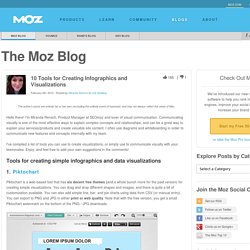
Hello there! I'm Miranda Rensch, Product Manager at SEOmoz and lover of visual communication. Communicating visually is one of the most effective ways to explain complex concepts and relationships, and can be a great way to explain your services/products and create valuable site content. Cloud, Big Data and Mobile: Dissecting Amazon ELB : 18 things you should know. While designing highly scalable systems load balancing tier becomes an integral part of any architecture.
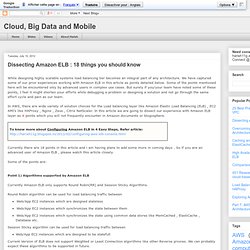
We have captured some of our prior experiences working with Amazon ELB in this article as points detailed below. Some of the points mentioned here will be encountered only by advanced users in complex use cases. But surely if you/your team have noted some of these points, I feel it might shorten your efforts while debugging a problem or designing a solution and not go through the same effort cycle and pain as our team.In AWS, there are wide variety of solution choices for the Load balancing layer like Amazon Elastic Load Balancing (ELB) , EC2 AMI’s like HAProxy , Nginx , Zeus , Citrix NetScaler.
In this article we are going to dissect our experience with Amazon ELB layer as X points which you will not frequently encounter in Amazon documents or blogosphere. Currently there are 18 points in this article and i am having plans to add some more in coming days . Article under progress. BigData. Hadoop 101: An Explanation of the Hadoop Ecosystem. Big data is taking off in 2014.

More companies than ever are finding uses for it, both for managing everyday business routines and for finding solutions to complex business problems. It’s quickly moving away from it’s position as a hype word and establishing itself as a viable technology for businesses and entities both big and small. Big data, simply put is the huge amounts of data that is all around us via smart devices, internet usage, social media, chat rooms, mobile apps, phone calls, purchasing history, and numerous other things. Oliver006/elasticsearch-gmail. OrmHate. Database · application architecture tags: While I was at the QCon conference in London a couple of months ago, it seemed that every talk included some snarky remarks about Object/Relational mapping (ORM) tools.
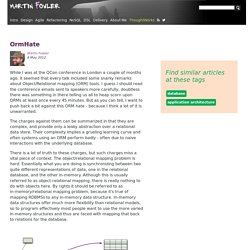
Vs SQL: Day 1-2. This will be the first post in an ongoing series based on our popular webinar about the differences in building an application using SQL versus building the same application using MongoDB.
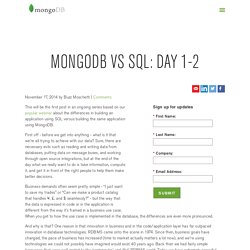
A Simple Use-case Comparison of JVM Libraries for MongoDB. MongoDB is one of my favorite data stores when it comes to storing document-based JSON data.
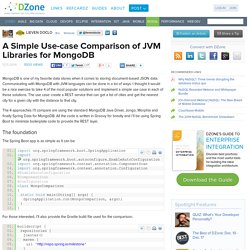
Communicating with MongoDB with JVM languages can be done in a lot of ways. I thought it would be a nice exercise to take 4 of the most popular solutions and implement a simple use case in each of those solutions. The use case: create a REST service that can get a list of cities and get the nearest city for a given city with the distance to that city. The 4 approaches I’ll compare are using the standard MongoDB Java Driver, Jongo, Morphia and finally Spring Data for MongoDB.
All the code is written in Groovy for brevity and I’ll be using Spring Boot to minimize boilerplate code to provide the REST layer. The foundation The Spring Boot app is as simple as it can be: 01.import org.springframework.boot.SpringApplication. MapDB: The Agile Java Data Engine. MapDB is a pure Java database, specifically designed for the Java developer.

The fundamental concept for MapDB is very clever yet natural to use: provide a reliable, full-featured and “tune-able” database engine using the Java Collections API. MapDB 1.0 has just been released, this is the culmination of years of research and development to get the project to this point. Jan Kotek, the primary developer for MapDB, also worked on predecessor projects (JDBM), starting MapDB as an entire from-scratch rewrite.